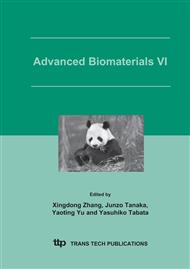[1]
Bruder SP, Fox BS: Tissue engineering of bone. Cell based strategies. Clin OrthopS68-S83, (1999).
Google Scholar
[2]
Schimandle JH, Boden SD: Spinal Fusion: Bone Grafts and bone Graft Substitutes for Spinal Fusion. In: The Spine, Rothman-Simeone pp.1610-1629. Ed by HN Herkowitz, RH Rothman, and FA Simeone. Philadephia, W.B. Saunders, 1999 A B C D.
DOI: 10.1016/b978-1-4160-6726-9.00067-5
Google Scholar
[3]
Wang W, Hu Y, Lu S: Study on the bone marrow mesenchymal stem cells differentiate into chondrocyte in vitro. Chin J Surg 38: 160, (2000).
Google Scholar
[4]
Lennon DP, Haynesworth SE, Young RG, Dennis JE, Caplan AI: A chemically defined medium supports in vitro proliferation and maintains the osteochondral potential of rat marrow-derived mesenchymal stem cells. Exp Cell Res 219: 211-222, (1995).
DOI: 10.1006/excr.1995.1221
Google Scholar
[5]
Uchida A, Kikuchi T, Shimomura Y: Osteogenic capacity of cultured human periosteal cells. Acta Orthop Scand 59: 29-33, (1988).
DOI: 10.3109/17453678809149339
Google Scholar
[6]
Cui C, Hu Y, Lei W: The influence of injectable osteoinductive material with rhBMP-2 and bFGF on the proliferation and ultrastructure of marrow stromal cell on rabit. Chin J Clin Rehabilitation 6: 2376-2377, (2002).
Google Scholar
[7]
Dou Y, Shun L, Hu Y: Construction and culture in vitro of deantigen bone xenograft block loaded with MSC and alginate. Modern Rehabilitation 5: 41-43, (2001).
Google Scholar
[8]
Spivak JM, Hasharoni A: Use of hydroxyapatite in spine surgery. Eur Spine J 10 Suppl 2: S197-S204, (2001).
DOI: 10.1007/s005860100286
Google Scholar
[9]
Martin I, Muraglia A, Campanile G, Cancedda R, Quarto R: Fibroblast growth factor-2 supports ex vivo expansion and maintenance of osteogenic precursors from human bone marrow. Endocrinology 138: 4456-4462, (1997).
DOI: 10.1210/endo.138.10.5425
Google Scholar
[10]
Yaylaoglu MB, Yildiz C, Korkusuz F, Hasirci V: A novel osteochondral implant. Biomaterials 20: 1513-1520, (1999).
DOI: 10.1016/s0142-9612(99)00062-9
Google Scholar
[11]
Cheng JC: Current concepts of surgical treatment of adolescent idiopathic scoliosis. In: Recent Advances in Orthopaedics Ed by S Bhan. India, Jaypee Brothers, (1994).
Google Scholar
[12]
DePalma AF, Rothman RH: The nature of pseudarthrosis. Clinical Orthopaedics & Related Research 59: 113-118, (1968).
DOI: 10.1097/00003086-196807000-00007
Google Scholar
[13]
Steinmann JC, Herkowitz HN: Pseudarthrosis of the spine. Clinical Orthopaedics & Related Research80-90, (1992).
DOI: 10.1097/00003086-199211000-00011
Google Scholar
[14]
Cheng JC, Guo X, Law LP, Lee KM, Chow DH, Rosier R: How does recombinant human bone morphogenetic protein-4 enhance posterior spinal fusion? Spine 27: 467-474, (2002).
DOI: 10.1097/00007632-200203010-00006
Google Scholar
[15]
Guo X, Lee KM, Law LP, Chow HK, Rosier R, Cheng CY: Recombinant human bone morphogenetic protein-4 (rhBMP-4) enhanced posterior spinal fusion without decortication. J Orthop Res 20: 740-746, (2002).
DOI: 10.1016/s0736-0266(01)00167-x
Google Scholar
[16]
Cinotti G, Patti AM, Vulcano A, Della RC, Polveroni G, Giannicola G, Postacchini F: Experimental posterolateral spinal fusion with porous ceramics and mesenchymal stem cells. J Bone Joint Surg Br 86: 135-142, (2004).
DOI: 10.1302/0301-620x.86b1.14308
Google Scholar
[17]
Boo JS, Yamada Y, Okazaki Y, Hibino Y, Okada K, Hata K, Yoshikawa T, Sugiura Y, Ueda M: Tissue-engineered bone using mesenchymal stem cells and a biodegradable scaffold. J Craniofac Surg 13: 231-239, (2002).
DOI: 10.1097/00001665-200203000-00009
Google Scholar
[18]
Kadiyala S, Young RG, Thiede MA, Bruder SP: Culture expanded canine mesenchymal stem cells possess osteochondrogenic potential in vivo and in vitro. Cell Transplantation 6: 125-134, (1997).
DOI: 10.1177/096368979700600206
Google Scholar
[19]
Bruder SP, Fink DJ, Caplan AI: Mesenchymal stem cells in bone development, bone repair, and skeletal regeneration therapy. J Cell Biochem 56: 283-294, (1994).
DOI: 10.1002/jcb.240560303
Google Scholar


